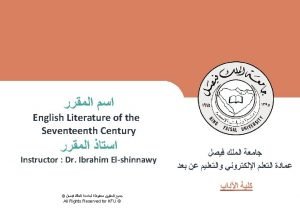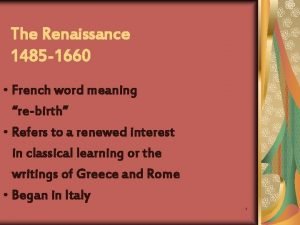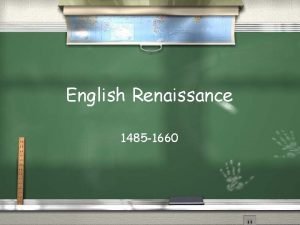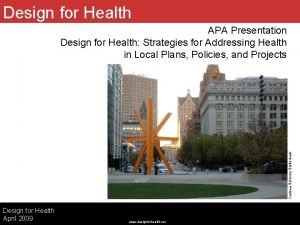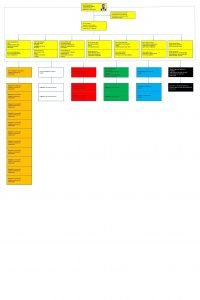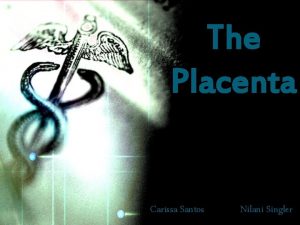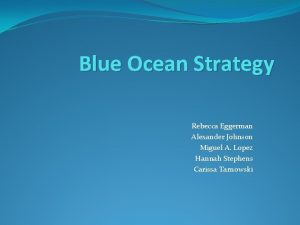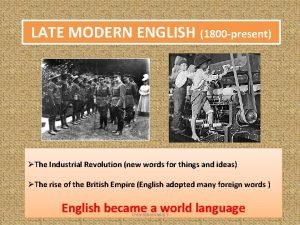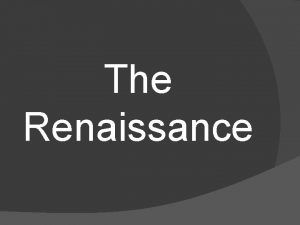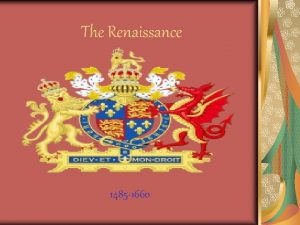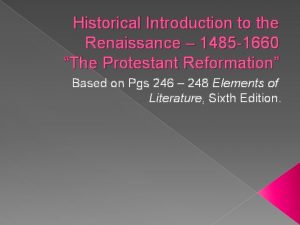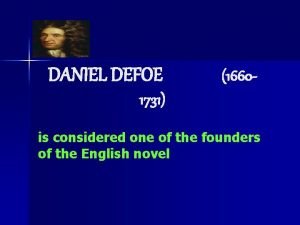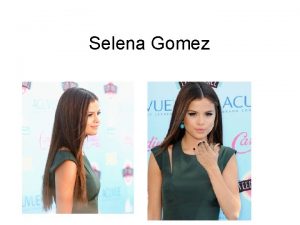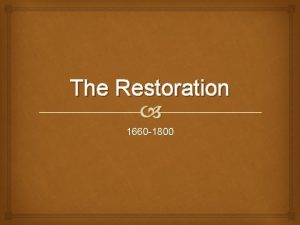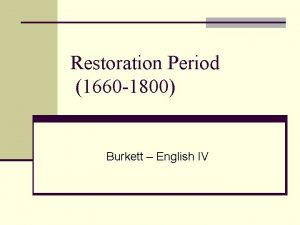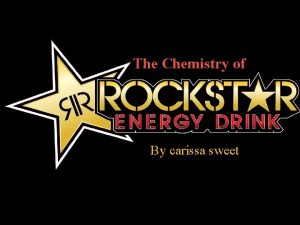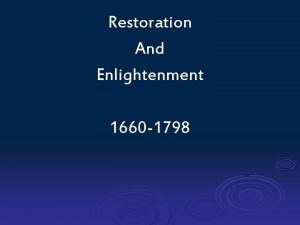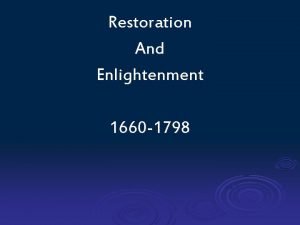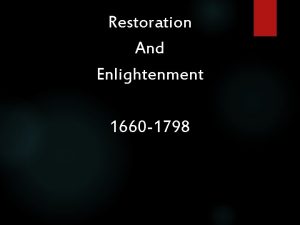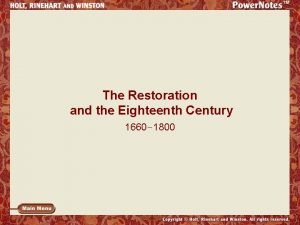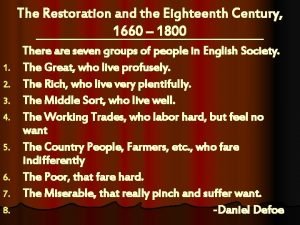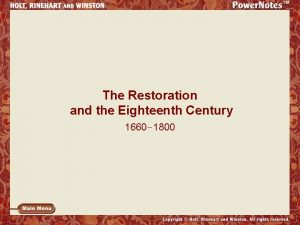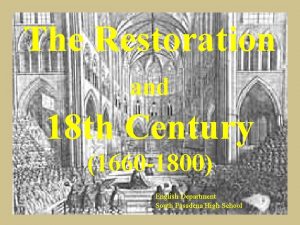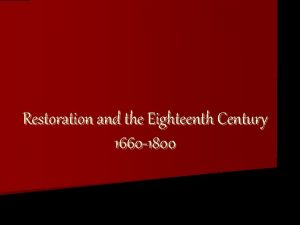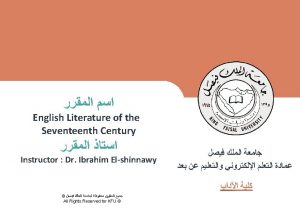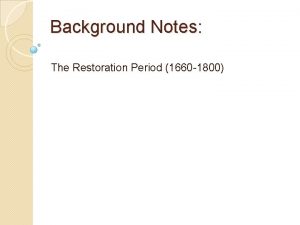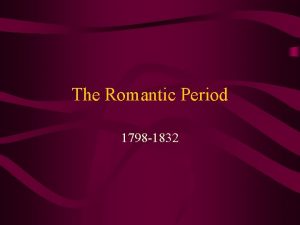English Restoration 1660 1800 Carissa Masuda and Selena
















- Slides: 16

English Restoration 1660 - 1800 Carissa Masuda and Selena Jimenez

History Charles ll The history of the English restoration begins when Charles l was ruler of England. He was a terrible ruler and was unjust, he overall wasn't great. Soon the parliament decided to overthrow the monarchy and kill Charles l. The person to take over was Oliver Cromwell instead of Charles l’s son Charles ll. Many civil wars took place but eventually Charles ll came out on top. He undid everything Cromwell had done and restored England back to its former glory.

Social Oliver Cromwell During Cromwell's rule social expectations were very strict and militaristic. Curfews were put into place, womens’ rights were stipped from them, and severe punishment was enforced if anyone was caught breaking these rules. After the restoration of the monarchy Charles ll undid all of this. He reopened theatres, women had a much more prominent role in society, and education was back to being important. To make an comparison, Elizabethan was much like this time.

Culture The culture was much like during the Elizabethan era. Theatre and the arts had a huge impact of the culture during this time. Women also had a lot more rights and for the first time are allowed to act on stage. Playwrights and theatres were popping up all over the place. New techniques and the introduction of indoor theatres. A very innovative time period. A theater during the English restoration

Comedy of Manners A type of comedy that satirizes social classes and mostly comments on the upper class’ behavior. It was very popular in the Restoration period and continued to be popular throughout the 19 th century. This was the main style of play written during this time. These plays were written in prose, and often included a prologue in the beginning, presented either as a monologue or a short scene by a few characters. The dialogue sometimes switched to the Shakespearean/Elizabethan style of English, but was mostly written in Early Modern English, which sounds exactly as one imagines a 17 th century, rich, British person would sound like. “I vow, Mr. Hardcastle, you’re very particular. Is there a creature in the whole country, but ourselves, that does not take a trip to town now and then, to rub off the rust a little? ” - Mrs. Hardcastle, She Stoops to Conquer Example : The School for Scandal by Richard Brinsley Sheridan : The inner-circle of the wealthy percentage of society is full of gossip and a deceit, as it is a part of the fashion. A woman named Lady Sneerwell is attempting to break up the relationship between Charles Surface and a young lady named Maria, as she wants Charles for herself. Sneerwell is aided by Joseph Surface, Charles’ brother, as Joseph wants the eventual fortune that is to fall to Maria. This play makes a comment about how wealthy people do crazy things out of selfishness - women want men, out of jealousy, and men want women, out of greed.

Heroic A type of tragedy that focuses on basic ideals like love, honor, and power. It is the less popular but still prevalent counterpart to the comedies. These plays were written in Early Modern English iambic pentameter. They were inspired by French Neoclassical tragedies, as well as traditional epics. Example : The Conquest of Granada by John Dryden : The Granada War was a series of military campaigns led by Catholic Monarchs Isabella I of Castile and Ferdinand II of Aragon. They wanted to be rid of Muslims in their countries and annexed the province of Granada, which was once ruled by Muslims. This play focuses on the Battle of Granada, the most prominent battle of the war, and a Muslim man fighting in the war who falls in love with a princess, but is forbidden from being with her. In typical tragedy fashion, this play greatly emphasizes themes on love and death.

William Congreve was probably one of the most well known playwrights and dramatists of this time period. He mostly wrote Comedy of Manners plays and they were his most popular. Plays like The Way of the World and Love for Love.

Richard Brinsley Sheridan Like Congreve he is well known even today with his most famous work being School for Scandal and The Rivals. Along with being a writer he also directed and was in parliment.

Thomas Killigrew was a playwright before the restoration and after it. He founded one of the main theatres, Drury Lane Theatre. Thomas Killigrew was very passionate about theatre and the arts being the first introduce women to the stage. He would see shows and write extensively about the play and its actors. He also wrote many plays one being The Parson’s Wedding, it is infamous because of it risque plot.

John Dryden was a poet and a playwright and he primarily wrote heroic tragedies. He used poetry to make large political statements and his playwriting to convey stories. His play All for Love is considered a masterpiece and one of the greatest plays from the restoration.

Set Before this time period, theaters were traditionally set outdoors. During Charles II’s reign, however, performance spaces were adapted to indoor settings, gatewaying the creation of new technical aspects to theatre. Illusionary depth and three-dimensionalism became popular at this time. Most Restoration theaters were built in the proscenium arch style, with a downstage play area similar to that of modern thrust stages. These stages were mostly raked to allow for even more depth and 3 D scenery. They also may have included moveable backdrops and flats, as well as trap doors and early versions of the fly system. This image depicts the Covent Garden Theater in London, 1763, undergoing a riot due to high ticket prices. Technical Theatre

Lighting Restoration lighting designers mainly used windows and candles as their sources of light, and were interested in Colored lights were created by the idea of using light to affect mood. Chandeliers and placing colored liquids into glass bottles and putting them in front footlights were distributed above, on, and to the sides of of the candles. Though a simple the stage as a means of creating the desired scene - less innovation, this paved the way to candles for sad scenes, more candles for happy scenes. modern gel lights. The invention of gas lamps around 1780 allowed for even more creativity. The intensity of light could easily be changed by adding or taking away oil (whereas before, candles were simply moved closer or farther from the stage), and colored lights were created by replacing the glass casing of the lamps with colored coverings. Palais Royal Theater, Paris, 1784 Technical Theatre

Costume Women : It was very fashionable, in this period, for ladies to seem taller. Waistlines were brought higher, and necklines were placed lower, in an almost off-theshoulder manner, and headdresses were made vertically. Typical dresses and skirts were adorned with frills, lace, ribbons, bows, and feathers, and short sleeves were increasingly popular. Women also carried fans, often made of ostrich feathers. For both men and women, color vibrancy, ribbon, and lace were very popular. A visual spectacle was important or audiences of the period. Men : Men’s costumes of the time has been argued to be even more extravagant than the women’s - heels and large, curly wigs (called periwigs) accompanied frilly adaptations of doublets, flared skirts, shortened sleeves (which was really just slightly above the wrist), and breeches. Men also wore cravats (pieces of cloth fashioned around the neck), cavalier hats (a large hat with a feather in it), and extravagant walking sticks. Technical Theatre

Makeup The spectacle continues with cosmetics, though stage makeup was noticeably different from the everyday style. Both men and women wore white face powders and patches cut into small shapes (hearts and diamonds being the most popular). Cheeks were colored to depict the health state of the character - red meant young and healthy, yellow meant old and sick. Eyes were outlined and shaded for a For men, facial hair was no longer dramatic look, and eyebrows were thin fashionable, and for women, rouge and high on the face. (red cream) was used on lips. Makeup of the time was, as we now know, unhealthy and unsafe - ironic, considering it was mainly used to cover disease markings. Technical Theatre

Deism- Views the world as perfect mechanism created by God. Elegy-a poem written to mourn someone's death Vocabulary Crass- Without sensitivity Wryd- Concept of fate Comitatus- Code of loyalty for warriors to fight and protect the king Cynicism-attitude towards the virtue of others

Bibliography Gaur, Aakanksha. “Heroic Play. ” Encyclopædia Britannica , Encyclopædia Britannica, Inc. , 15 June 2017, www. britannica. com/art/heroic-play. Isis, Madame. “ 17 th And 18 th Century Stage Makeup - La Commedia Dell'Arte. ” Google Sites , 29 Dec. 2014, sites. google. com/site/italiancommedia/costumes-masks-and-makeup/17 th-and-18 th-century-stage-makeup. “Restoration Drama and Prose. ” Restoration Drama and Prose , www. bachelorandmaster. com/englishperiods/restoration-dramaprose. html#. W 8327 ekp. B-E. “Restoration Drama. ” Restoration Drama , theatrehistory. com/british/restoration_drama_001. html. Ross, David. “Oliver Cromwell and the Restoration of the Monarchy. ”Britain Express , www. britainexpress. com/History/Cromwell_and_Restoration. htm. Sampaolo, Marco. “Comedy of Manners. ” Encyclopædia Britannica , Encyclopædia Britannica, Inc. , 13 Mar. 2018, www. britannica. com/art/comedy-ofmanners. Trueman, CN. “Life in England under Oliver Cromwell. ” History Learning Site , History Learning Site, 17 Mar. 2015, www. historylearningsite. co. uk/stuartengland/life-in-england-under-oliver-cromwell/. Comedy Restored: or, Ten English Plays of Manners. Doubleday, 1986.
 Masuda
Masuda The puritan age
The puritan age Renaissance is the french word for
Renaissance is the french word for The english renaissance 1485 to 1660
The english renaissance 1485 to 1660 Carissa schively slotterback
Carissa schively slotterback Carissa cabrera
Carissa cabrera Cnh cyberkey
Cnh cyberkey Description of placenta
Description of placenta Carissa tarnowski
Carissa tarnowski Carissa mills
Carissa mills Deficit calorico
Deficit calorico English 1800
English 1800 Jacobean age
Jacobean age The renaissance 1485-1660
The renaissance 1485-1660 Renaissance (1537 ad - 1660 ad)
Renaissance (1537 ad - 1660 ad) Daniel defoe (1660-1731)
Daniel defoe (1660-1731) Daniel defoe was born in 1660 into a family of dissenters
Daniel defoe was born in 1660 into a family of dissenters

